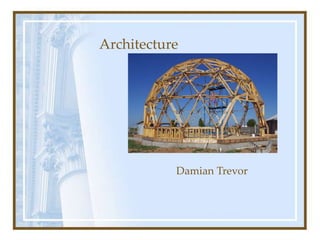Damian Trevor - Architecture
- 2. • The art and science of designing and constructing buildings Architecture Damian Trevor
- 3. Architects: specialists in designing structures Architecture Damian Trevor
- 4. Architecture One of the early architectural developments was the use of the “post-and-lintel” method A beam is placed horizontally across upright posts. Damian Trevor
- 5. Architecture Ancient Greek “Orders” (styles): composed of a shaft, capital, and base. (click me) http://www.bozzle.com/perClassicOrders.html Damian Trevor
- 6. Architecture Entablature: the top of an order; includes the architrave, frieze, and cornice. http://penelope.uchicago.edu/~grout/encyclopaedia_romana/architecture/entablature.html Damian Trevor
- 7. Architecture Other key developments include the arch, http://www.arlington.k12.va.us/schools/drew/a&a/theromans.htm Damian Trevor
- 8. Architecture the vault, http://www.arlington.k12.va.us/schools/drew/a&a/theromans.htm Damian Trevor
- 9. Architecture and the dome (my personal favorite). http://www.arlington.k12.va.us/schools/drew/a&a/theromans.htm Damian Trevor
- 10. Architecture The arch was a purely Roman invention. An arch is often made up of small stones called voussoir and a large central stone called a keystone. Damian Trevor
- 11. Architecture A series of columns is called a colonnade. A series of arches is called an arcade. Damian Trevor
- 12. Architecture The arch, vault, and dome are variations of the same concept that allowed for greater height and more space inside a building. Damian Trevor
- 13. Architecture The Romans were great engineers. They developed concrete as a building material, which was used in building aqueducts, baths, and other public works projects. Damian Trevor
- 14. Architecture http://www.m-w.com/mw/art/flyingbu.htm Flying Buttress: external arch that counter- balanced the outward thrust of the high, vaulted ceilings. Damian Trevor
- 15. Architecture During the Industrial Revolution, many new materials were developed: glass-- Crystal Palace (1851) http://www.uh.edu/engines/epi1158.htm Damian Trevor
- 16. Architecture and wrought iron: The Eiffel Tower Damian Trevor
- 17. Modern Architecture Antonio Gaudi: Spanish architect– no flat surface or straight lines (organic) http://www.lexised.com/architecture/gaudi/casam.html Damian Trevor
- 18. Antonio Gaudi’s most famous building: “La Sagrada Familia” Modern Architecture Damian Trevor
- 19. Modern Architecture The 1st skyscraper was made in St. Louis, MO by Louis Sullivan who coined the expression “form follows function”. Damian Trevor
- 20. Modern Architecture Frank Lloyd Wright: American architect; carefully considered the environment where the building was to be constructed. “Falling Water” More Wright Damian Trevor
- 21. Modern Architecture Steel and concrete are the favored materials for commercial type construction. Wood and brick are the favored materials for residential construction. Damian Trevor





















